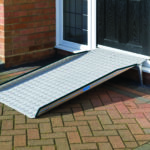Ramps for elderly individuals are incredibly useful for people with limited mobility. Wheelchairs and other mobility aids like electric scooters and walkers can make accessibility a challenge, with steps and thresholds into buildings posing real barriers.
With many types of ramps for elderly individuals out there, all having their own functions and advantages, knowing the differences is helpful in finding the ideal mobility ramp type for your situation.
- What Type of Ramp do I Need?
- Folding Portable Ramps
- Threshold Ramps or Door Wedge Ramps
- Suitcase Ramps
- Telescopic Access Ramps
- Modular Ramp
- Permanent Access Ramp
- Ramp Assessments
- Conclusion
What Type of Ramp do I Need?
When it comes to choosing access ramps for the elderly, there is a wide selection of options available. This is great, because it means that ramps are versatile and can suit a broad range of user needs. However, the number of choices on offer can also make it difficult to decide which kind of ramp is right for you.
But there’s no need to feel overwhelmed! Each type of ramp is designed for a specific purpose. So, by answering some simple questions when looking for a ramp, you can quickly narrow down the options and find an access ramp that meets your needs.
Here are the three key questions you should be asking before you choose a ramp:
1) Where will the ramp be used?
The kind of ramp that you need depends on where the ramp will be used. Different materials are designed for use on different surfaces, and there are certain regulations that apply to ramps used in public places but not ramps intended for domestic use. Read more about the rules for disability ramps.
2) What size ramp do I need?
After deciding on which style of ramp you might want, it is also important to make sure you choose a ramp that is the correct size for your needs.
There are three main measurements that you need to think about when choosing what size ramp to get — gradient, length, and width.
How Steep?
| Steepness Gradient | Acceptable For… |
| 1:6 (10-degree angle) | Some short thresholds, after the completion of a risk assessment. |
| 1:8 (8-degree angle) | Situations where gradient needs to be balanced with available space. Again, a risk assessment should be completed first. This gradient is often used when selecting portable ramps. |
| 1:12 (5-degree angle) | Most social services and local authorities. This is the minimum requirement installed ramps under Building Regulation. |
| 1:15 (4-degree angle) | Installed public access ramps. |
How long?
| Height of the tallest step is up to… | Ramp length at 1:6 | Ramp length at 1:8 | Ramp length at 1:12 | Ramp length at 1:15 |
| 10cm (4ins) | 60cm (2ft) | 80cm (2ft 8ins) | 120cm (4ft) | 150cm (5ft) |
| 15cm (4ins) | 90cm (3ft) | 120cm (4ft) | 180cm (6ft) | 225cm (7ft 5ins) |
| 20cm (8ins) | 120cm (4ft) | 160cm (5ft 4ins) | 240cm (8ft) | 300cm (9ft 10ins) |
| 25cm (10ins) | 150cm (5ft) | 200cm (6ft 8ins) | 300cm (10ft) | 375cm (12ft 4ins) |
| 30cm (1ft) | 180cm (6ft) | 240cm (8ft) | 360cm (12ft) | 450cm (14ft 9ins) |
| 45cm (11ft 6ins) | 270cm (9ft) | 360cm (12ft) | 540cm (18ft) | 675cm (22 ft 2ins) |
| 60cm (2ft) | 360cm (12ft) | 480cm (16ft) | 720cm (24ft) | 900cm (29 ft 6ins) |
Width
- The size of your wheelchair or mobility scooter — Before purchasing a ramp, double-check that it is wide enough to comfortably fit your wheelchair or scooter.
- The size of the threshold — Ideally, the ramp will be as wide as the threshold being crossed. For example, if your doorway was 36ins wide you should look for a ramp that is 36ins wide. This prevents the risk of falling over the edge of the ramp when using it. Many ramps are width-adjustable to fit a range of thresholds.
3) Do you need a ramp for more than one location?
The final thing to consider is whether you want a portable ramp or one that is permanently installed. It may even be that you opt for both — a permanent ramp for the main entrance and a portable one to use for internal thresholds.
Permanent vs. Portable Ramps
A portable ramp folds or breaks down into component parts, to make it easier to store and transport.
They are also useful when the ramp isn’t needed all the time. For example, if you have a relative with reduced mobility then you may choose to get a portable ramp to assist them when they come to visit. Or, if you have a wheelchair or scooter which you don’t use on a daily basis then you may prefer to have a portable ramp in your own home so that you can store it away on the days where you don’t need it.
Portable ramps also don’t require any installation. This means that they are typically cheaper and delivered faster than permanent ramps.
However, a portable ramp can be inconvenient if you suddenly need it when it isn’t set up. They can also be less stable than some permanent options when being used in a single location for prolonged periods.
With these three questions in mind, let’s have a look at the different types of ramps, where they are designed to be used, and some examples to help you visualise the different choices.
Folding Portable Ramps
The ramp of choice for many on the move, foldable ramps for wheelchairs can hold anywhere from 250-350kg (550-770lbs) and are designed with multiple panels that have hinges between them.
These panels fold up making them ideal for when you are on the move but unsure of accessibility options at your destination.
Some, like the Aerolight Xtra Ramp, even fold down to reveal handles so they can be carried like a suitcase! As they are designed to be moved around, they are also very lightweight.
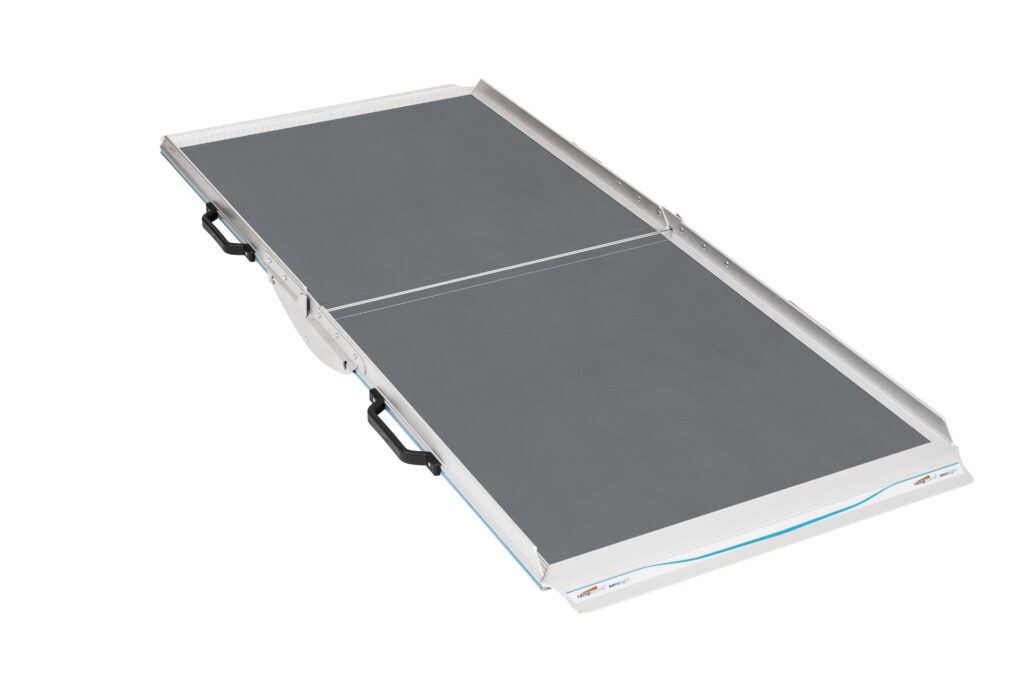
This kind of ramp is great for people who like to travel. If you have a robust wheelchair or scooter which can handle most terrains, then a portable ramp can be handy for the times where you just need a bit of assistance whilst you’re on the go.
Folding ramps do not have handrails and because of this, they should only be used for personal use.
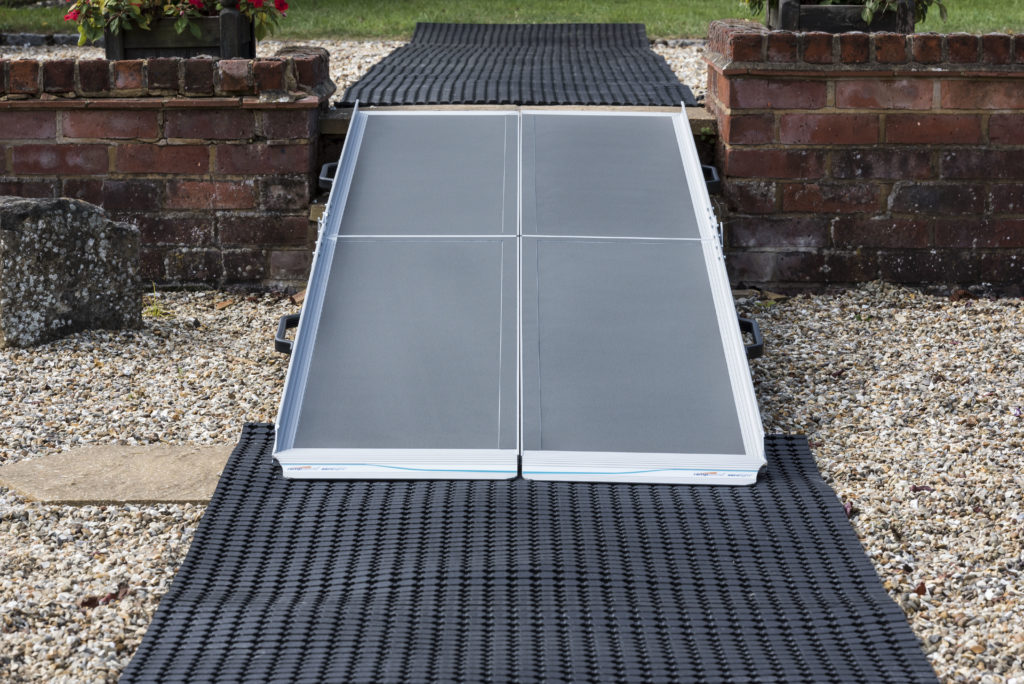
The Aerolight Range has lots of fantastic, cost-effective options for aluminium ramps. They offer full-width non-slip ramps that are protected against corrosion for prolonged outdoor use.
Threshold Ramps or Door Wedge Ramps for Elderly
Threshold or ‘door wedge’ ramps are designed to fill the space between a doorframe or threshold and the ground. An outdoor threshold ramp would be used to provide barrier-free access into a building by placing it between the doorframe and ground.
Usually the easiest way to have a safe home ramp, threshold ramps are wonderfully portable, making them a quick and low-budget option to a common problem.
Threshold ramps can’t be permanently placed under a doorframe and must be removed after use.
Wedges
These small, sleek slopes are mainly designed for crossing internal thresholds. For example, you may use a wedge-style ramp between your living room and kitchen.
Although wedges are typically used indoors, you can also use them on external doorways providing the frame isn’t raised too high.
But when choosing a ramp for external doors, you may prefer a ramp which is specially designed to work well with the material the door is made from. This helps to ensure stability and prevents damage to the door.
PVC-Friendly Ramps for Elderly
These ultra-lightweight ramps are specifically designed for use on PVC surfaces. This makes them a very popular choice for front doors.
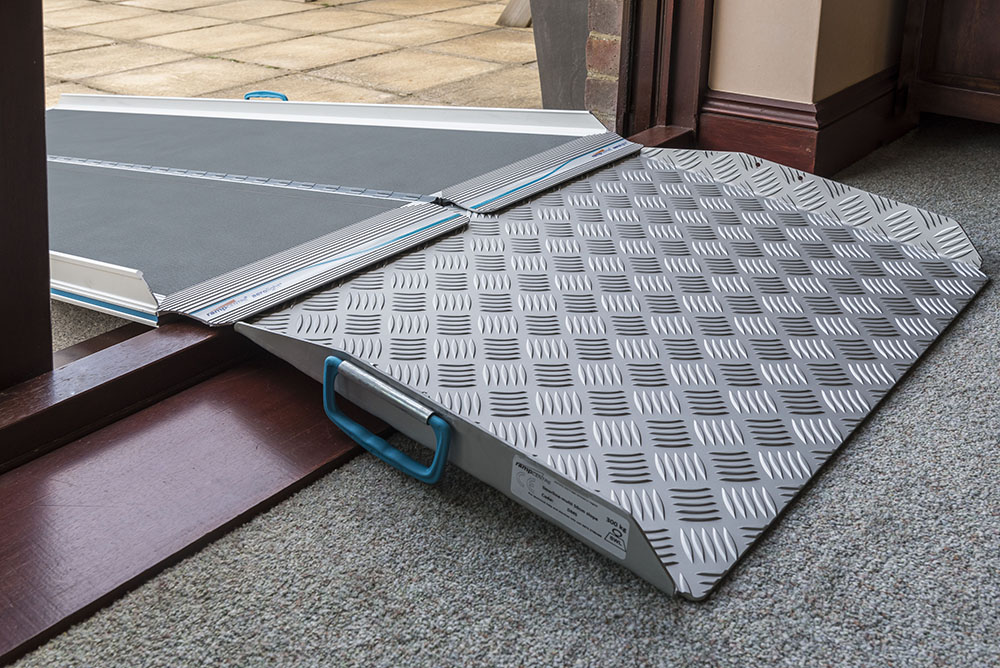
The Doorline Multi has a unique rubber anti-slip lip that secures the ramp onto the doorway and protects the PVC frame.
Ramps for Wooden/Level-Access Door Thresholds
Previously, we mentioned that you can use wedges on some external thresholds.
Well, external doors that have a wooden doorframe or level-access point, i.e. a single, flat doorstep, are examples of when it can be possible to use this type of ramp outside.

The Doorline Neatedge is perfect for outdoor use as it is made from weather-resistant rubber.
Suitcase Ramps
Much like a folding ramp, a suitcase ramp is another type of door ramp that can also be folded away for easy storage but also comes equipped with a handle for easier portability.
It can be placed directly over some small steps, making it perfect for home use. Suitcase ramps do not have handrails and because of that, they should only be for personal use.
Telescopic Access Ramps for Elderly
A telescopic ramp is another style of portable ramp for wheelchair access. The telescopic ramp is made of two, narrow separate channels that work much like a traditional telescope. The channels can be extended and retracted to the desired length.
Vehicle Access Ramps
As the name suggests, these ramps are designed to help get wheelchairs and scooters in and out of vehicles. Carers often turn to these ramps because they cannot lift the mobility aid into the vehicle by themselves.
For vehicle access, you will want to select a folding or telescopic ramp. This will allow you to store the ramp more easily when it is not in use.
The Ultralight comes in 2 or 3 section versions to suit vehicles with different amounts of storage space. This style of ramp is called a channel ramp, it is made up of two slim parallel ramps rather than one single section.
Telescoping ramps are not ideal for mobility scooters as the wheels are sometimes not in line with each other.
In these cases, the Aerolight Lifestyle is often used instead. It can still be split into 2 sections, which can then be folded, for storage. But it’s also full width which can be easier to use.

These types of access ramps are particularly helpful when getting into non-wheelchair accessible vehicles but be wary of headroom for the wheelchair user when inside the vehicle.
They provide a practical way of getting over uneven areas and due to their narrow, super compact design, these types of ramps can be stored in a vehicle’s boot or even under seats.
Telescoping ramps don’t have handrails and are only suitable for personal use because of this.
Modular Ramps for Elderly
The middle ground between portable and permanent ramps, modular ramps are certainly a more permanent fixture than various types of portable ramps and but as they are not built into an area, they don’t require special building consent to install.
They are usually made of multiple aluminium sections so that they can be disassembled if they need to be installed at a different location.
Importantly, because modular ramps are large, semi-permanent structures, they can be constructed with safety features like handrails and kerb rails and are suitable for commercial environments.
The Welcome Ramp System is a great option for this. It is made from modular components, which means it can be easily adjusted to work with most sets of stairs. You can also add handrails to give more support for users.

Permanent Access Ramps for Elderly
A permanent ramp is typically made from aluminium, concrete or wood that is fixed in place. At Aquadapt, our team of experts can take care of the design, manufacture, and installation of custom-built home ramps.
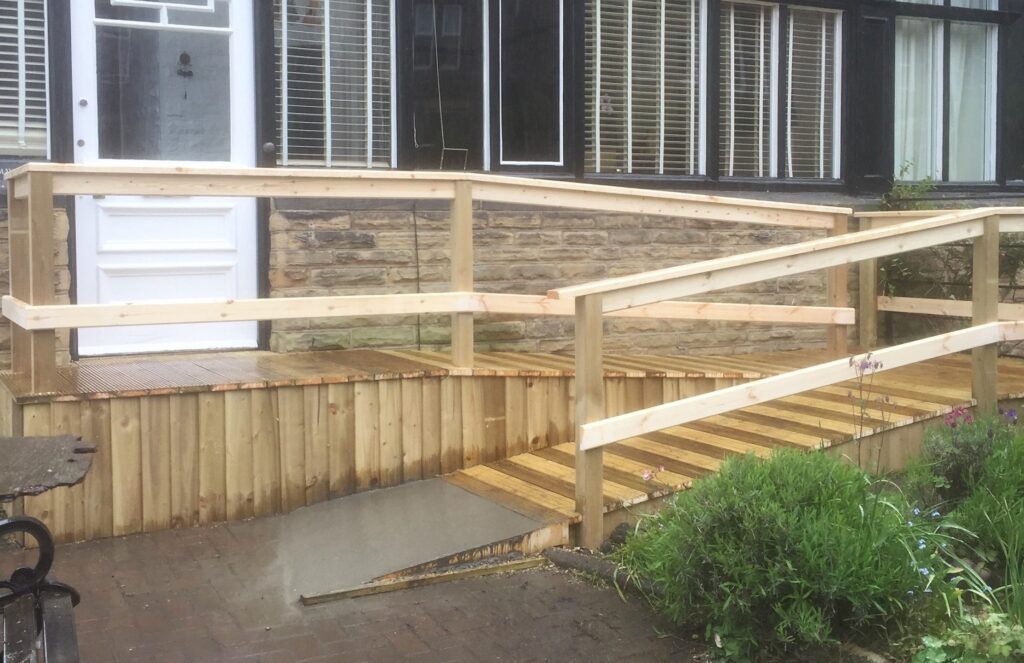
The fact that permanent ramps can be custom-built is often one of the reasons why people choose them. It gives you greater control over both the functionality and the appearance of the ramp. They can be built to your exact specifications and can be much more attractive than portable ramps.
They are popular for entrances. Many people who use wheelchairs or mobility scooters every day prefer to have a permanent ramp at their front door. They are also better suited to public places which need to be accessible to all e.g. libraries, schools or hospitals.
Permanent wheelchair ramps are also usually built with handrails making them ideal from a visual and practical standpoint.
Ramp Assessments
If you are considering a permanent ramp system, or you have a complex situation, then we would recommend a no-obligation site survey from one of our specialists.
Conclusion
When choosing a ramp there are a lot of options and factors to consider. But answering the three simple questions provided in this guide will help you to find the ramp that best suits your needs. Consider where your ramp will be used, what size it needs to be, and whether it needs to be portable before you make a choice. Once you’ve done this, you’ll be able to decide whether a rubber wedge, lightweight telescopic ramp, or custom-built ramp system is the right choice for you.
Frequently Asked Questions
Q: What type of access ramp do I need?
A: The right ramp depends on where it will be used, how steep the access point is, and whether you need it to be portable. There are ramps designed for thresholds, vehicles, steps, and even public buildings. Start by identifying the space and use case.
Q: How do I know what size ramp I need?
A: You’ll need to consider three key measurements:
Gradient (steepness) – A 1:12 slope is standard for permanent ramps, while portable ramps can use steeper gradients.
Length – The higher the step, the longer the ramp required for a safe incline.
Width – The ramp should be wide enough for your mobility aid and the threshold it’s crossing. Many ramps are adjustable.
Q: What’s the difference between portable and permanent ramps?
A: Portable ramps (like folding, suitcase, or telescopic ramps) are lightweight, movable, and ideal for temporary use.
Permanent ramps are fixed structures, often made from wood, metal, or concrete, and ideal for everyday or public use.
Modular ramps offer a balance: they’re semi-permanent, made from connectable sections, and can be reassembled if needed.
Q: What are threshold or wedge ramps used for?
A: Threshold ramps (also called door wedge ramps) are small, sloped ramps designed to bridge short height differences between rooms or over doorframes. They’re ideal for indoor use and easy to move.
Q: Which ramp is best for travel or vehicle access?
A: Folding or suitcase ramps are great for personal use on the go.
Telescopic ramps are compact and extendable, ideal for use with vehicles.
Just note: Mobility scooters may not work well with channel-style telescopic ramps due to wheel placement.
Q: Are there ramps suitable for narrow doorframes or PVC doors?
A: Doorline Multi ramps are designed for PVC frames and have non-slip lips to prevent damage.
Rubber ramps like the Doorline Neatedge are perfect for outdoor use and weather-resistant.
Q: What are modular ramps and when should I choose one?
A: Modular ramps are made from lightweight aluminium sections that can be configured to suit various spaces. They’re ideal for people who need something more durable than a portable ramp but don’t want a fixed, permanent ramp.
Q: What safety features should I look for in a ramp?
A: Non-slip surfaces
Handrails (on permanent or modular ramps)
Kerb rails to prevent rolling off
Rubber grips for added stability on thresholds
Q: Can you install permanent ramps for homes and public buildings?
A: Yes, our team at Aquadapt offers full-service design and installation for custom-built ramps made from wood, aluminium, or concrete. These are ideal for daily use or to meet public accessibility requirements.
Q: How can I get help choosing the right ramp?
A: We offer free, no-obligation ramp assessments. Our specialists will visit your home, measure your space, and recommend the best solution based on your needs.





